Palm oil churns trouble in Canadian ‘hard butter’ puzzle
The pandemic has increased demand for butter, so farmers are feeding extra palm oil derivatives to their cows to produce more milk fat.
Just In
Canadian toast lovers have been complaining about strangely hard, unspreadable butter for months now.
Food researcher Sylvain Charlebois, the senior director of Dalhousie University’s Agri-Food Analytics Lab, last year noticed differences between organic butter and regular supermarket butter which was no longer spreadable at room temperature.
After researching the matter, Charlebois became convinced that the increased use of palmitic acid, a by-product of palm oil that’s commonly added to cow feed, is the most likely culprit.
In October, the British Columbia Milk Marketing Board posted a memo about problematic issues with non-foaming milk in which it mentioned a link between added fatty acids and non-foaming milk.
This is the milk used in butter production.
Charlebois told NPR radio that dairy sector sources told him that a pandemic-inspired shift had happened at the farm milk production level before the butter manufacturing even begins.
“Palm oil-based cow food isn’t new, it’s been used for more than a decade,” he said. “Farmers regularly add palmitic acid to their feed as an energy supplement to help cows produce more butter fat content.”
However, production slowdowns and a boom in home cooking in the pandemic has put new pressure on dairy farmers to produce more milk for butter.
Butter sales actually grew by over 12% in 2020, according to the Dairy Farmers of Canada.
To keep up with the pandemic surge in butter demand, Charlebois says that farmers have been boosting the amount of palm oil-based feed in their cows’ diets to step up butter supply.
“Little research has been done on the health consequences of palm oil-based dairy,” he said. “Whether or not the butter is healthy, we just don’t know.”
Canadian Food Inspection Agency regulations stipulate that butter products must contain at least 80% milk fat. Adding palm oil to butter is legal, Charlebois said, but the question now is, “Should it be legal?”
It’s not only health but environmental effects that concern him and many in the dairy industry, as well as environmental watchdogs.
Palm oil has not been enjoying a favourable international reputation for the past few years because of the vast amounts of rainforest destroyed for palm oil plantations in Malaysia and Indonesia.
Charlebois told NPR on Tuesday, “The concerning environmental and social impacts associated with palm oil production abroad, does not help an industry that’s concerned about its public image.”
On Wednesday, a group representing some of Canada’s major dairy producers yielded to mounting consumer pressure by calling for a ban on palm-based dairy products.
Citing environmental concerns related to palm oil production, the Quebec Milk Producers group is now “asking its milk producers to stop using products containing palm oil or its derivatives in the feed of their dairy cattle”.
Subscribe to our newsletter
To be updated with all the latest news and analyses daily.
